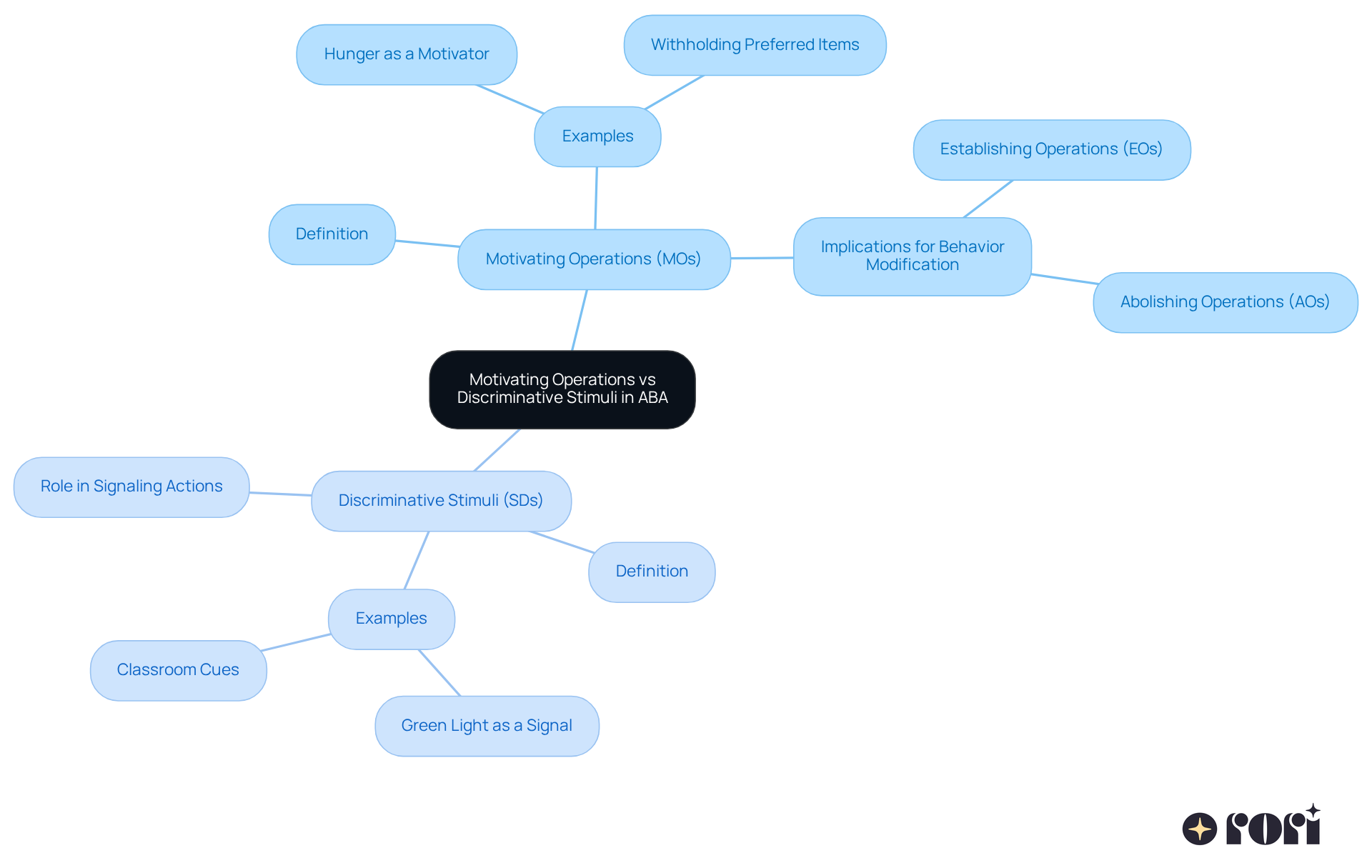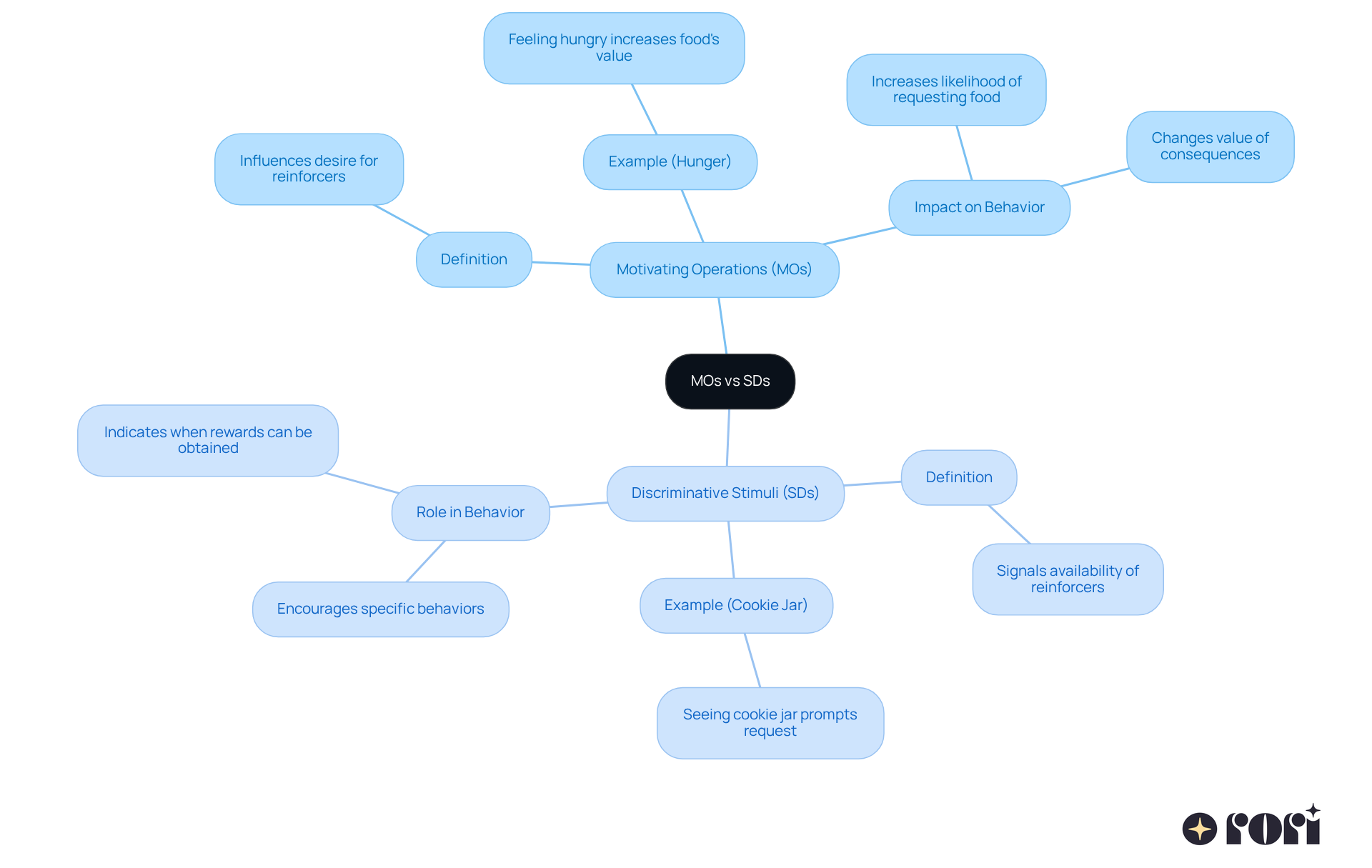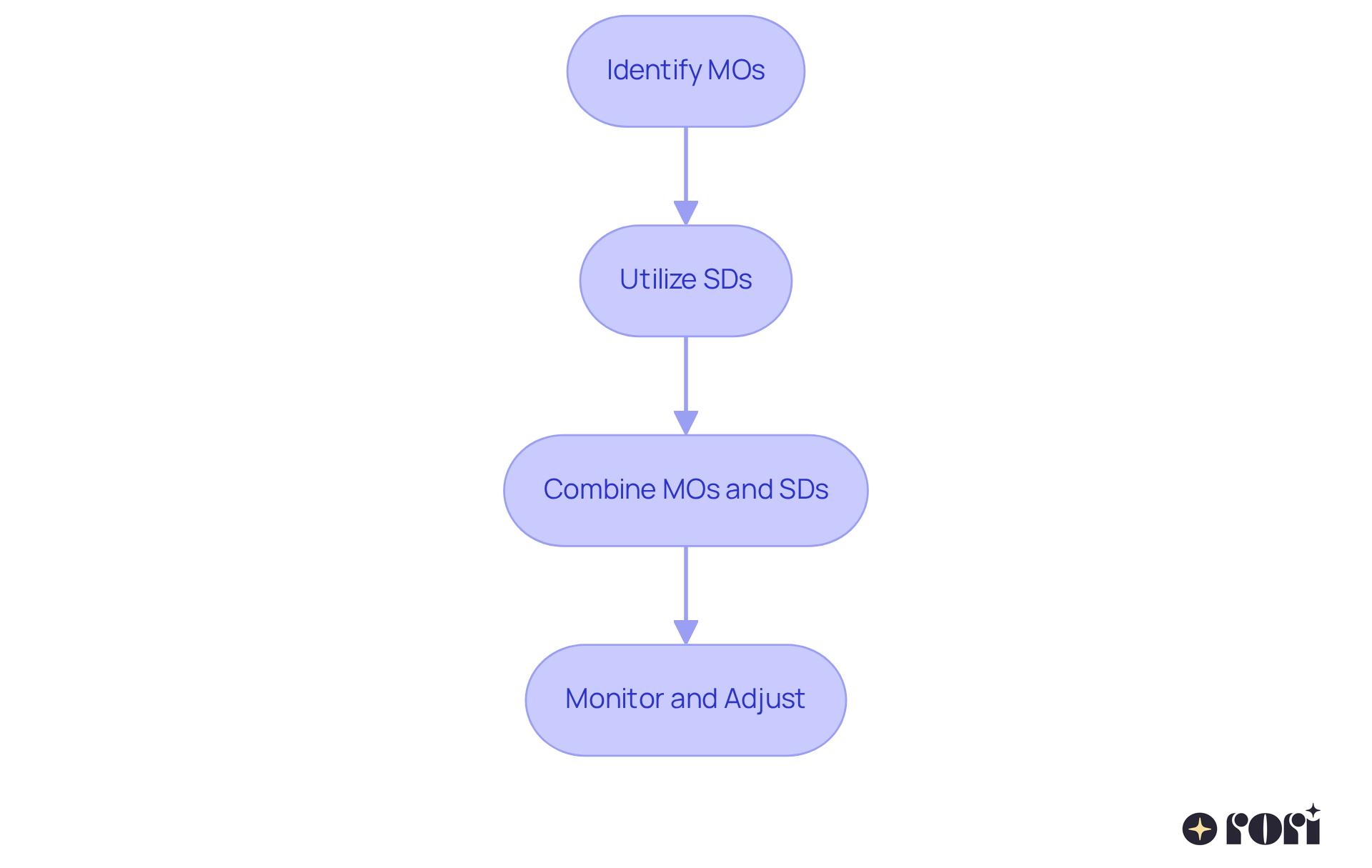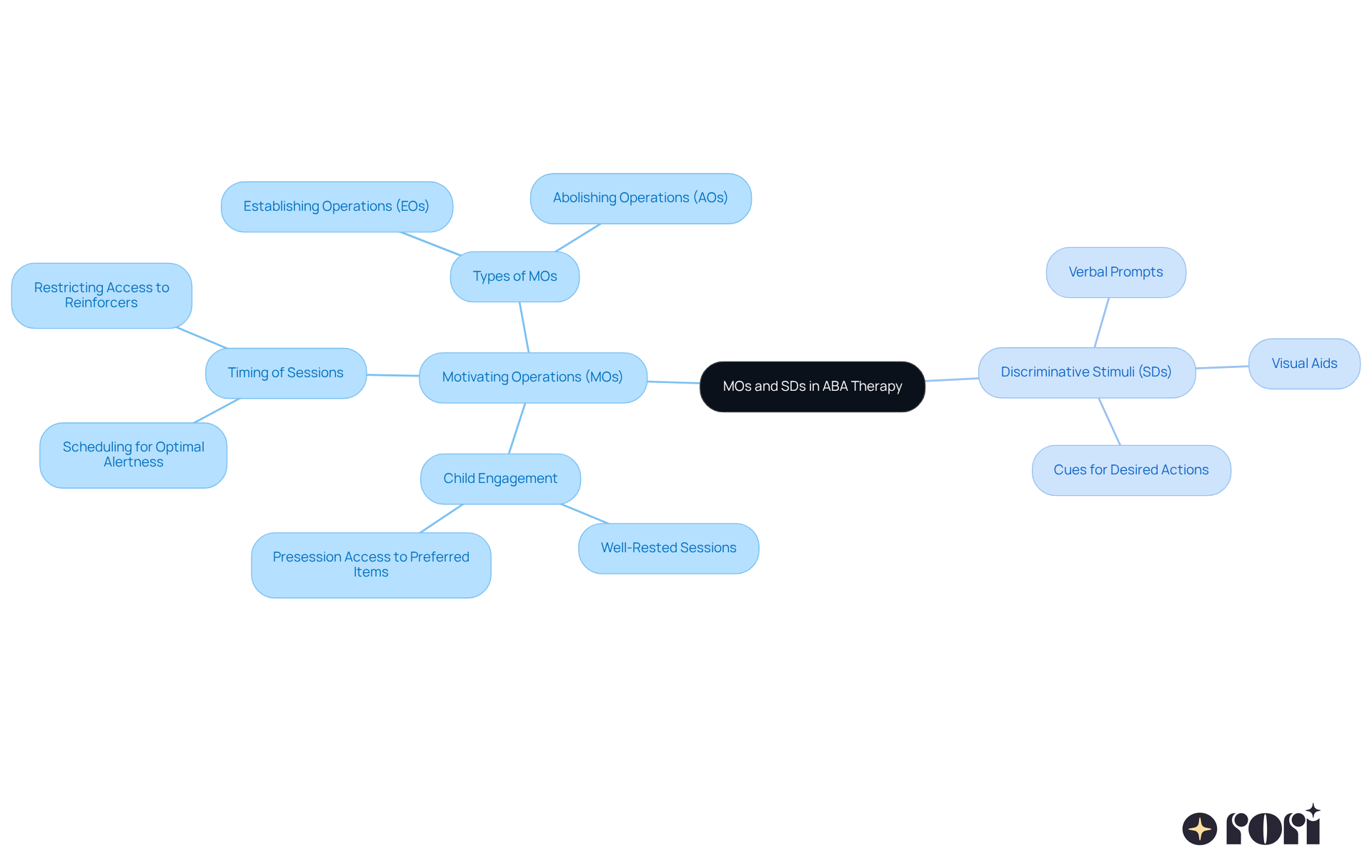This article dives into the differences between Motivating Operations (MOs) and Discriminative Stimuli (SDs) in Applied Behavior Analysis (ABA). It highlights how these concepts play a crucial role in shaping effective behavior strategies for children, especially those with autism. 😊
MOs are all about understanding how current needs influence the value of reinforcers. Meanwhile, SDs signal when certain actions will lead to rewards. By grasping these ideas, parents can better support their child's behavioral goals. Tailored strategies and active participation make a world of difference!
Let’s explore this together and see how understanding these concepts can empower you in your parenting journey. We’re here to help you every step of the way!
Navigating the world of Applied Behavior Analysis (ABA) can feel overwhelming for parents, but understanding the intricacies of behavior management is crucial. At the heart of this journey are two key concepts:
These elements not only influence how children respond to their surroundings but also lay the groundwork for effective behavior modification strategies.
So, how can you, as a parent, use these insights to encourage positive behavioral changes in your child? This article dives into the essential differences and applications of MOs and SDs, offering practical guidance for caregivers eager to support their child's growth. Let’s explore this together!
In Applied Behavior Analysis (ABA), the discussion of MOs vs SDs illustrates how Motivating Operations (MOs) play a vital role in our environment, influencing how valuable a reinforcer or punisher feels, and ultimately guiding our actions. Think about it: when a child feels hungry, food suddenly becomes a strong motivator, making them more likely to seek it out. On the flip side, Discriminative Stimuli (SDs) serve as specific signals that tell us when a certain action will be rewarded. For instance, a green light signals that it’s safe to cross the street, encouraging us to take that step safely. Understanding these concepts can really help parents see how different factors can inspire or indicate actions in their kids, which is key for effective behavior modification strategies.
When caregivers are equipped with knowledge about MOs vs SDs, they become better allies in supporting their child's behavioral goals. Recent studies have shown the significant role of MOs vs SDs in autism therapy, revealing how adjusting these operations can lead to better behavioral outcomes. For example, limiting access to preferred items can actually increase motivation for important actions, like communicating during toilet training. This approach acts as an establishing operation (EO), making the desired action more significant. Plus, using deprivation strategies, such as reducing access to certain foods or activities, can further boost motivation. By regularly evaluating and modifying environmental factors, skilled analysts can craft personalized strategies that effectively promote positive change. This collaborative approach, where caregivers actively participate in gathering data and aligning strategies, empowers them with the essential knowledge and skills to support their children effectively. MOs truly become a crucial part of the journey in the context of MOs vs SDs, helping individuals with autism. Let’s explore this together!

MOs and SDs, often referred to as mo vs sd aba, are both important factors that influence behavior, but they play different roles. Motivating Operations (MOs) change how effective a reward or punishment is, depending on what a person needs at the moment. For example, imagine a child who hasn't eaten for a while; their hunger makes food seem much more appealing as a reward. This shows how feeling deprived can really boost the desire for certain things, which in turn affects behavior.
On the other hand, Discriminative Stimuli (SDs) signal when a reward is available for a specific behavior. Picture a child spotting a cookie jar on the table—this SD encourages them to ask for a cookie because they know their request is likely to be fulfilled. In a nutshell, MOs fuel the motivation behind actions, while SDs indicate when those actions will be rewarded. Understanding these differences is key for using mo vs sd aba strategies effectively to help individuals with autism.
As Dana Meller puts it, "Motivating operations make you want or not want something; discriminative stimuli let you know it’s available." Plus, getting to know the four-term contingency model—MOs, SDs, responses, and consequences—can really enhance how we apply the principles of mo vs sd aba to change behaviors.
By working with qualified analysts who develop personalized plans with clear goals—like improving communication skills or reducing challenging behaviors—parents can learn how to effectively use MOs and SDs in their child's management program. Caregiver education is crucial, as it equips parents with the knowledge and skills they need to support their child's growth, leading to better behavioral outcomes and healthier family dynamics. Let’s explore this together!

To effectively apply Motivating Operations (MOs) and Discriminative Stimuli (SDs) in behavior modification, let’s explore some friendly strategies that can make a difference:
Identify MOs: Start by observing your child’s behavior to see what truly motivates them. MOs can be both Establishing Operations (EOs), which boost the value of a reinforcer, and Abolishing Operations (AOs), which reduce it. For instance, if your child is more likely to engage in play after a snack, hunger might be acting as a motivating operation. Recognizing these conditions can really enhance engagement! Research shows that 90% of young individuals make significant advancements when caregivers are actively involved. Your role is crucial in supporting your child's development through consistent participation and understanding their needs.
Utilize SDs: Create clear cues that signal when an action will be rewarded. For example, if you want your child to practice saying 'please' before receiving a toy, hold the toy out only when they use the word. This approach taps into the power of SDs and mo vs sd aba, prompting behaviors by indicating that responding in their presence is likely to lead to reinforcement. By being aware of ABA principles, you can make choices that positively influence your child’s progress.
Combine MOs and SDs: For maximum effectiveness, try using both concepts together! If your child is tired (an MO), they might be less responsive to SDs. Ensure they are in a good state for learning before presenting SDs. The interplay between MOs and SDs, particularly in the context of mo vs sd aba, is key for shaping behavioral outcomes. Your active involvement and alignment with therapeutic strategies can lead to more effective and lasting improvements.
Monitor and Adjust: Keep an eye on how your strategies are working! If a specific MO or SD isn’t hitting the mark, be flexible and adjust your approach based on your child’s reactions. Maintaining high treatment integrity—averaging 97.42% across participants—can lead to better results in behavior modification. By equipping yourself with knowledge and skills through caregiver education, you can boost your confidence in supporting your child, ultimately enhancing family dynamics. Plus, the care engine revises intervention and skill acquisition plans after each session based on progress, ensuring your strategies stay effective and tailored to your child’s evolving needs.

In personalized ABA therapy, understanding MOs vs SDs in ABA is essential for shaping effective treatment plans. Qualified behavior analysts take the time to evaluate each child's unique motivations and environmental cues. This thoughtful approach allows them to create tailored interventions that truly align with each child's specific needs.
For instance, consider MOs: A therapist might notice that a child is more engaged when they’re well-rested. By scheduling therapy sessions when the child is likely to be alert and receptive, the therapist ensures that the intervention is customized to the individual’s optimal state for learning.
Now, let’s talk about SDs. Therapists can introduce visual aids or specific verbal prompts that signal when a child should perform a desired action, like using a communication device to request help. This reinforces the connection between cues and actions, making learning more intuitive.
Additionally, our care engine conducts functional analysis for target actions and skills, producing automatic progress reports for clinician review. By grasping and applying MOs vs SDs in ABA, therapists can foster a more effective and responsive therapy environment. This approach is continuously supported by evaluating and modifying treatment plans, which are essential for encouraging positive behavior changes and skill acquisition.
Ultimately, this structured methodology leads to better outcomes for children with autism. It empowers caregivers to actively participate in their child's behavioral goals through data collection and the application of ABA principles. Let’s explore this together! We’re here to help you every step of the way!

Understanding the distinctions between Motivating Operations (MOs) and Discriminative Stimuli (SDs) is so important for parents navigating the complexities of Applied Behavior Analysis (ABA). When you recognize how MOs can enhance the value of reinforcers and how SDs signal the availability of rewards, you can effectively influence your child's behavior and support their developmental goals. This knowledge empowers you to become an active participant in your child's behavioral journey, fostering a more collaborative and informed approach to behavior modification.
The article highlights the importance of identifying MOs and utilizing SDs to create effective strategies for behavior modification. For instance:
By combining these concepts, you can tailor your interventions to meet your child's unique needs, leading to more effective outcomes. Plus, continuous monitoring and adjustment of strategies ensure that your interventions remain relevant and impactful as your child grows.
Ultimately, understanding and applying MOs and SDs in ABA therapy underscores the importance of caregiver involvement in achieving positive behavioral changes. By actively engaging in your child's therapy and employing these strategies, you can significantly enhance their progress and improve overall family dynamics. Remember, the journey of behavior modification isn’t just about changing actions; it’s about fostering a deeper connection and understanding between you and your child, paving the way for lasting growth and development. Let’s explore this together!
What are Motivating Operations (MOs) in Applied Behavior Analysis (ABA)?
Motivating Operations (MOs) are environmental factors that influence how valuable a reinforcer or punisher feels, thereby guiding our actions. For example, when a child is hungry, the desire for food becomes a strong motivator.
What are Discriminative Stimuli (SDs) in ABA?
Discriminative Stimuli (SDs) are specific signals that indicate when a certain action will be rewarded. For instance, a green light signals that it is safe to cross the street, prompting individuals to take that action.
How do MOs and SDs relate to behavior modification strategies?
Understanding MOs and SDs helps parents and caregivers recognize how different factors can inspire or indicate actions in their children, which is essential for effective behavior modification strategies.
How can knowledge of MOs and SDs benefit caregivers in supporting their child's behavioral goals?
When caregivers understand MOs and SDs, they can better support their child's behavioral goals by implementing strategies that adjust these operations to promote positive behavioral outcomes.
What role do MOs play in autism therapy?
Recent studies have shown that MOs play a significant role in autism therapy, where adjusting these operations can lead to improved behavioral outcomes, such as increasing motivation for important actions like communication during toilet training.
What is an establishing operation (EO)?
An establishing operation (EO) is a type of motivating operation that makes a desired action more significant. For example, limiting access to preferred items can increase motivation for actions like communication.
How can deprivation strategies enhance motivation?
Deprivation strategies, such as reducing access to certain foods or activities, can further boost motivation for desired behaviors.
How can skilled analysts create personalized strategies using MOs and SDs?
Skilled analysts can regularly evaluate and modify environmental factors to craft personalized strategies that effectively promote positive change, empowering caregivers to actively participate in the process.
Why is collaboration between caregivers and analysts important in behavior modification?
Collaboration is important because it allows caregivers to actively participate in gathering data and aligning strategies, equipping them with the knowledge and skills necessary to support their children effectively.